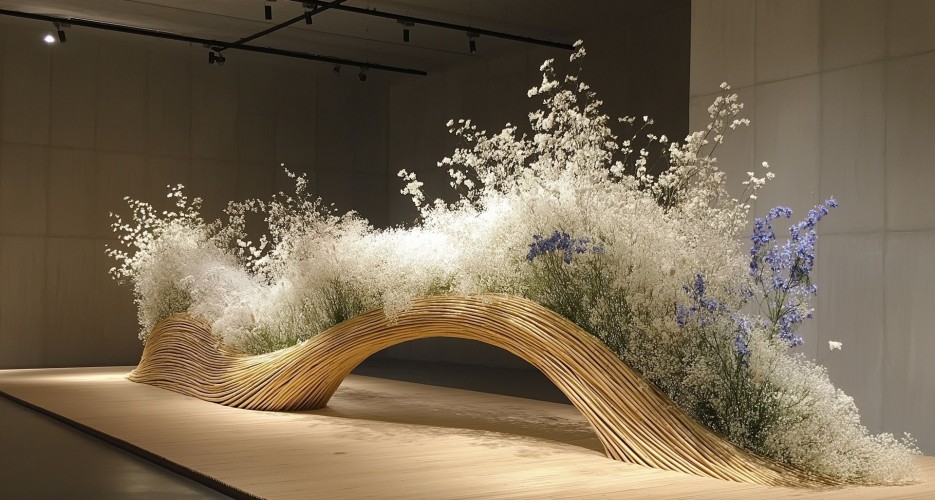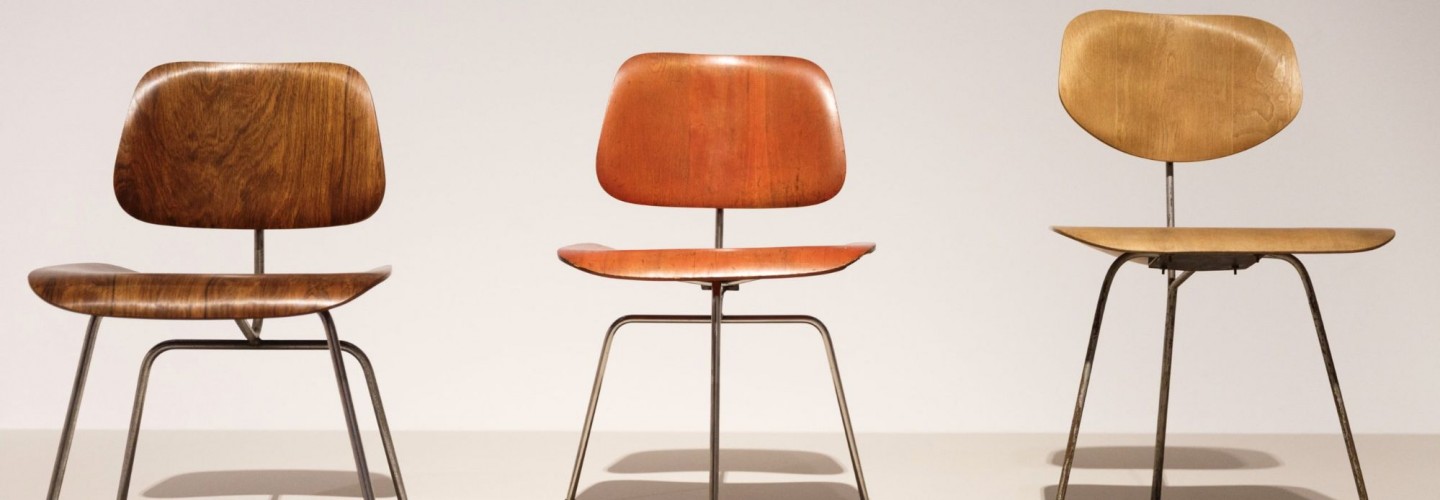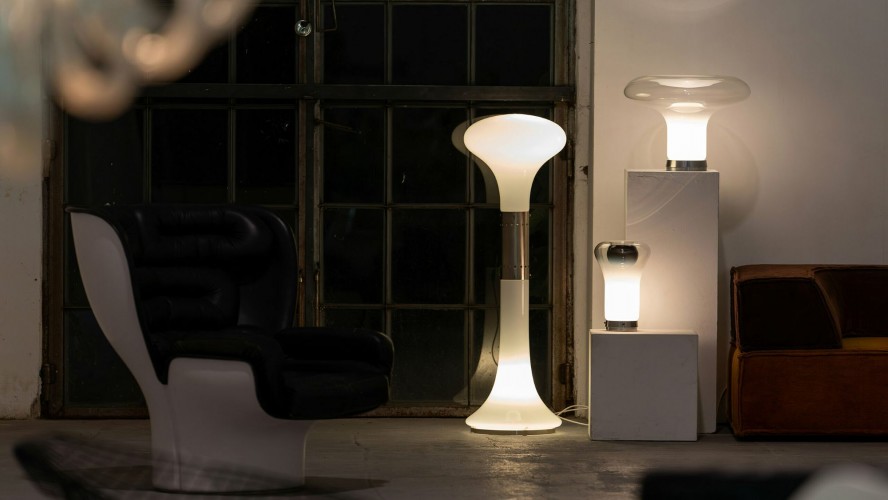Έπιπλα Σχεδιασμένα από Εικαστικούς
DS.WRITER:
Sophia Throuvala
Στην ιστορία της τέχνης, το έπιπλο χρησιμοποιήθηκε με πολλούς τρόπους, ως decor, ως μέρος των performance ή ακόμα και ως statement, κυρίως από τις φεμινίστριες καλλιτέχνιδες που ήθελαν να κάνουν λόγο περί οικιακής συνθήκης. Υπήρξαν όμως και πραγματικές κατασκευές, θα λέγαμε, επίπλων, χρηστικών και σχεδιασμένων έτσι ώστε να ακροβατούν μεταξύ τέχνης και design. Υπάρχουν έπιπλα και έπιπλα σε μουσεία, εκθέσεις και συλλογές, άλλα ιστορικά τεκμήρια, άλλα συλλεκτικά αντικείμενα και άλλα έργα τέχνης, που είτε δημιουργήθηκαν από καλλιτέχνες και έτσι κέρδισαν μια θέση στους χώρους αυτούς, είτε κατασκευάστηκαν για να δημιουργήσουν μια έντονη σύνδεση μεταξύ τέχνης και καθημερινής ζωής, επιζητώντας τη συμμετοχή του κοινού. Παρακάτω θα αναλυθούν κάποια παραδείγματα γνωστών καλλιτεχνών, που όμως δεν ήταν, κυρίως, designers. Βασικότερος λόγος που τα έργα αυτά μπορούν να θεωρηθούν (και) έπιπλα, πέραν του σχεδιαστικού φορμαλισμού τους που παραπέμπει σαφώς σε έπιπλα, είναι η χρηστικότητα που τα χαρακτηρίζει. Στα πλαίσια αυτά, διάσημοι καλλιτέχνες όπως ο Jean Dubuffet (French, 1901–1985), ο Franz West Donald Judd, ο Salvador Dali, ο Richard Artschwager και άλλοι, δημιούργησαν τα δικά τους έπιπλα, αγκαλιάζοντας με τον τρόπο αυτόν τη γλώσσα του design.
Ο Salvador Dalì, τη δεκαετία του ’30, ξεκινάει στενή φιλία με τον επιπλοποιό και σχεδιαστή εσωτερικών χώρων Jean-Michel Frank, και μαζί ξεκινούν μια σειρά από μεταμορφώσεις καθημερινών αντικειμένων, δηλαδή μετατρέπουν χρηστικά αντικείμενα σε αντικείμενα προσωπικής χρήσης. Ο καναπές-χείλη (εικ.1) είναι ένα έπιπλο που δημιουργήθηκε το 1936, με αφορμή τα “αισθησιακά χείλη” τής ηθοποιού Mae West. Ο σουρεαλιστής ζωγράφος σχεδίασε όλα τα έπιπλά του έτσι ώστε να μοιάζουν παραπλανητικά ως κάτι άλλο, ή διαστρεβλώνοντας την προοπτική τους όπως στη λάμπα δαπέδου Bracelli Lamp του 1930 (εικ. 2), ή ακόμα κάνοντας αναφορά στα ίδια του τα εμβληματικά ζωγραφικά έργα, όπως για παράδειγμα με το έπιπλο Leda Low Table (εικ.3), του οποίου το σχέδιο πραγματοποιήθηκε το 1930 ενώ η κατασκευή του τη δεκαετία του 1990.
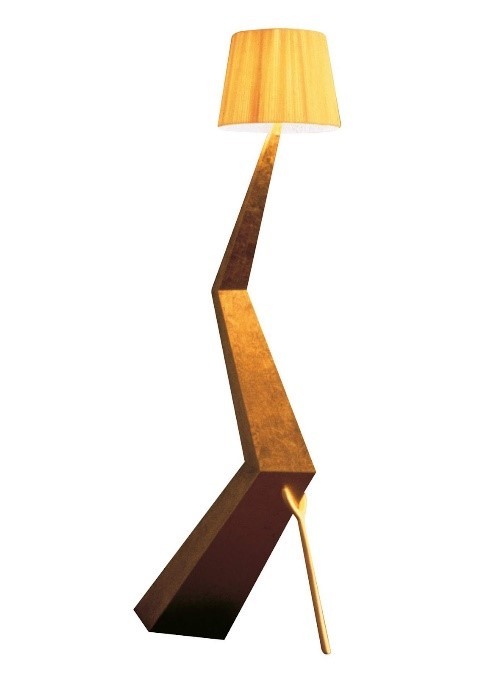
Εικ. 2: Bracelli Lamp conceived in the 1930's, first production in the 1990's BD Barcelona Design
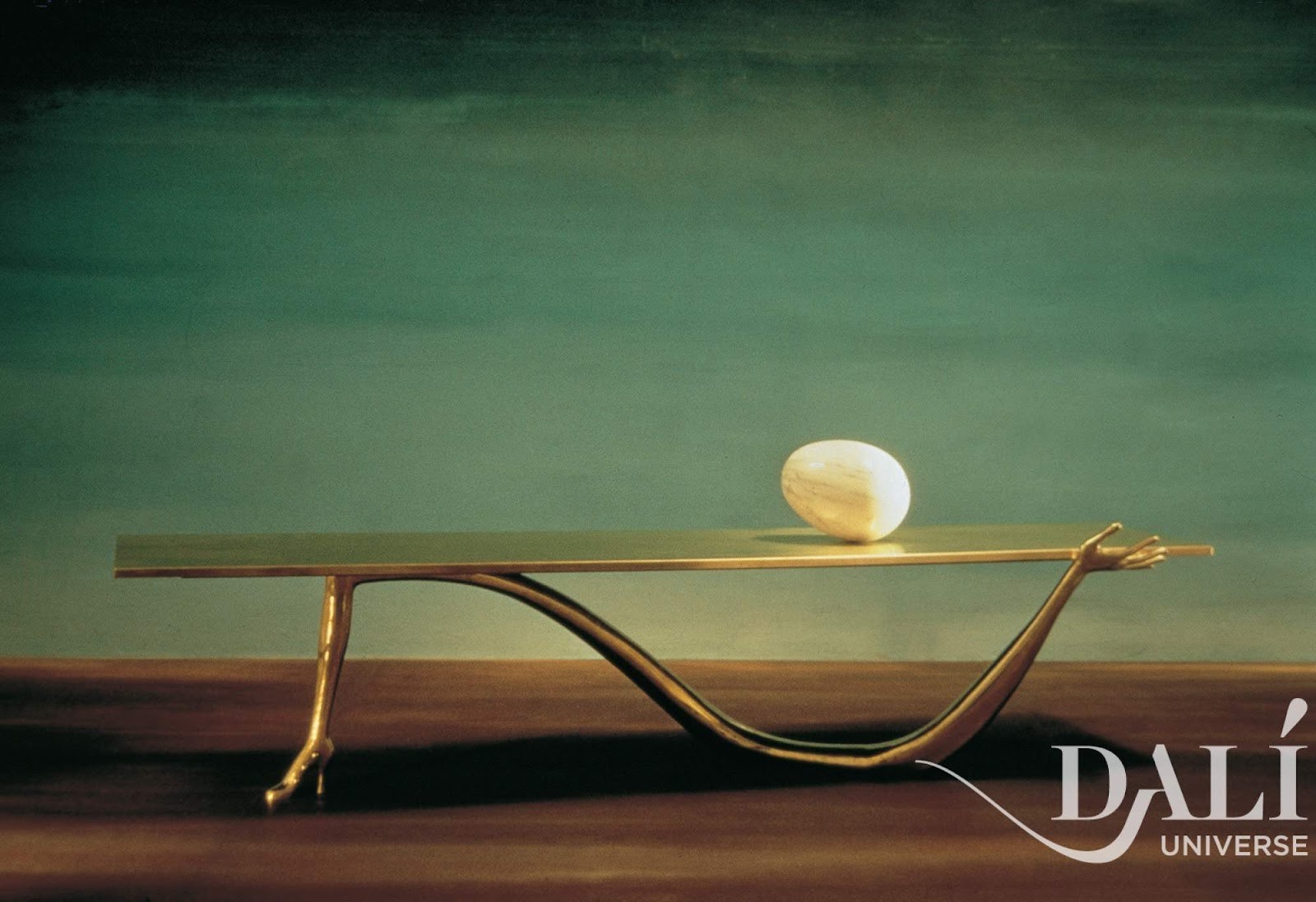
Εικ. 3: Leda Low Table conceived in the 1930's, first production in the 1990's BD Barcelona Design
Ο Jean Dubuffet ήταν Γάλλος εικαστικός και δημιουργός του όρου και της ομάδας ART BRUT. Η ART BRUT ήταν ένας συγκερασμός γλυπτικής και “ακατέργαστης” ζωγραφικής, δηλαδή μιας μεθόδου απόθεσης υλικών, όχι απαραίτητα ζωγραφικών, το ένα επί του άλλου χωρίς αισθητικές παρεμβάσεις. Εμπνευσμένος από την τέχνη των πρωτόγονων, την παιδική ζωγραφική και τις κατασκευές των τροφίμων φυλακών και ασύλων, δημιούργησε τόσο γνωστά, σοκαριστικά έργα του, όπως και μερικά έπιπλα. Συγκεκριμένα, το 1972 δημιουργεί μια σύνθεση σαλονιού η οποία απαρτίζεται από ένα τραπεζάκι καφέ και μια καρέκλα με τίτλο “Guéridon and Chaise de Pratique Fonction II” (εικ. 4), δηλαδή καρέκλα πρακτικής λειτουργίας. Ο τίτλος θέτει το ερώτημα αν ο καλλιτέχνης επιζητά τη συμμετοχή ή ειρωνικά τη σχολιάζει. Μια πρωιμότερη (1969) τέτοια καρέκλα βρίσκεται σήμερα στο Μουσείο Μοντέρνας Τέχνης Βασίλη και Ελίζας Γουλανδρή, με τίτλο πάλι Guéridon and Chaise de Pratique Fonction I (εικ. 5), η οποία μάλιστα τοποθετείται διαγώνια στον τοίχο, καθιστώντας τη χρήση της αδύνατη.
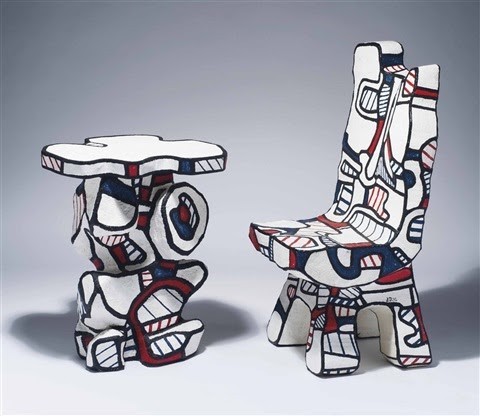
Εικ. 4: Guéridon and Chaise de Pratique Fonction II
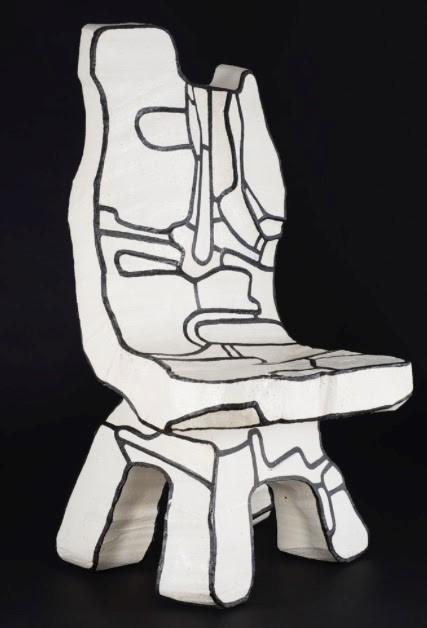
Εικ. 5: Chaise de pratique fonction, Jean Dubuffet, B&E Goulandris Foundation, Athens © Adagp, Paris, 2021
Ο Αυστριακός καλλιτέχνης Franz West ποτέ δεν ενδιαφέρεται πραγματικά για την τέχνη η οποία κρέμεται από τους τοίχους, όπως ο ίδιος έχει πει: “It doesn't matter what the art looks like but how it's used”. Η ίδια του η ζωή και οι επιλογές του, η καλλιτεχνική του παραγωγή και η συμμετοχή του σε ριζοσπαστικά κινήματα όπως των Βιεννέζων Αξιονιστών, φανερώνουν πως η τέχνη πρέπει να αφορά κυρίως το κοινό και τη σχέση μεταξύ δημιουργού-αντικειμένου και θεατή. Συγκεκριμένα, τα Passstücke (Adaptives) του, δηλαδή οι μορφές που δημιουργούσε τη δεκαετία του ’80, δεν ήταν παρά έπιπλα. Ξεκίνησε να δημιουργεί τις πρώτες του καρέκλες μαζί με τον Mathis Esterhazy από ευτελή υλικά, όπως εφημερίδες, ενώ αργότερα χρησιμοποίησε μέταλλο, και δεν είναι λίγοι εκείνοι που αποφάνθηκαν πως πρόκειται για τις πιο άνετες καρέκλες που έχουν χρησιμοποιήσει (And I think his dining chairs are among the most comfortable that I’ve come across, says art dealer David Zwirner). Τόσο ως προς τη μορφή όσο και ως προς τη χρηστικότητα, ο West δημιουργούσε έπιπλα-συνθήκες προκειμένου να χρησιμοποιηθούν από το κοινό, όπως για παράδειγμα στο έργο με τίτλο Auditorium που εγκατέστησε στην Documenta IX του Kassel το 1992, και ακολούθως στο Pompidou (1994) και πρόσφατα στην Tate (2019). (εικ.6)
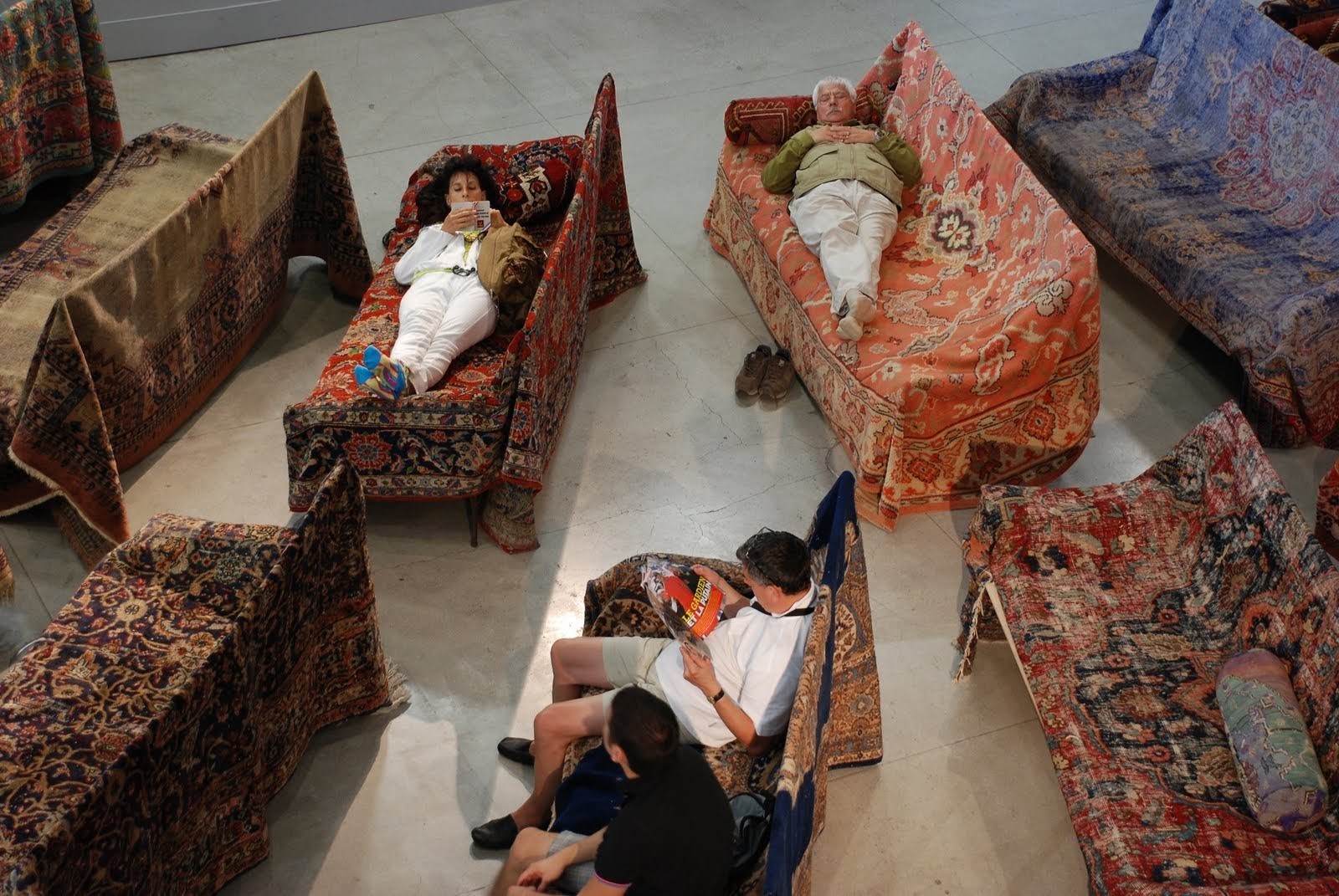
Εικ. 6: Franz West Auditorium, 1992 Documenta Kassel

Εικ. 7: Donald Judd, Armchair, designed 1984, fabricated 1998; SFMOMa, photo: Katherine Du Tiel
Ένας από τους σημαντικότερους καλλιτέχνες του εικοστού αιώνα, ο Αμερικανός Donald Judd, συνέδεσε στα έργα του την αρχιτεκτονική, το design και τη γλυπτική. Ο Judd, εκτός από καλλιτέχνης, θεωρητικός και κριτικός, ήταν επίσης συλλέκτης επίπλων. Στη συλλογή του είχε έργα από σπουδαίους αρχιτέκτονες και σχεδιαστές, όπως του Alvar Aalto, του Ludwig Mies van der Rohe, του Gerrit Rietveld και του Rudolph Schindler μεταξύ άλλων. Αν και έχει μείνει γνωστός ως “γλύπτης”, είχε σχεδιάσει σειρά επίπλων-έργων η οποία ονομάστηκε “specific objects”. Στη σειρά αυτή ο Judd επιχείρησε να αντλήσει στοιχεία από έπιπλα της συλλογής του, βάζοντας και το προσωπικό του μινιμαλιστικό ιδίωμα, με στόχο να κατασκευάσει έργα τα οποία ο θεατής θα μπορούσε να χρησιμοποιήσει. Τέτοια έργα είναι αυτά που παρουσιάστηκαν στον 6ο όροφο της έκθεσης “specific furniture” του SfMOMa το 2018. Εκεί παρουσιάστηκαν τόσο έργα της συλλογής του όσο και δικές του δημιουργίες (όπως το Armchair, 1984) (εικ.7), προκειμένου η σχέση μεταξύ τους να είναι φανερή.
Ο Αμερικανός γλύπτης και ζωγράφος Richard Ernst Artschwager, ο οποίος ασχολήθηκε, και αυτός, με τον μινιμαλισμό ενώνοντας το design με τη γλυπτική, δημιούργησε γλυπτά-έπιπλα και συνθέσεις επίπλων. Τα γλυπτά αυτά έμοιαζαν στο σχήμα και λειτουργούσαν ως έπιπλα, ωστόσο ήταν ένα σύνολο από στερεά σχήματα, τα οποία, λόγω της επιζωγράφισής τους, πληροφορούσαν τον θεατή για τη χρήση που έπρεπε να κάνει. Όπως περιέγραφε ο ίδιος, τα έργα του αποτελούν “χρήσιμα έπιπλα με μια επίστρωση αναπαράστασής τους” (“useful furniture with an overlay of representation”). Χαρακτηριστικό είναι το έργο (μέρος performance) με τίτλο, Table and Chair, του 1963–4 (εικ. 8) που παρουσιάστηκε στην Tate.
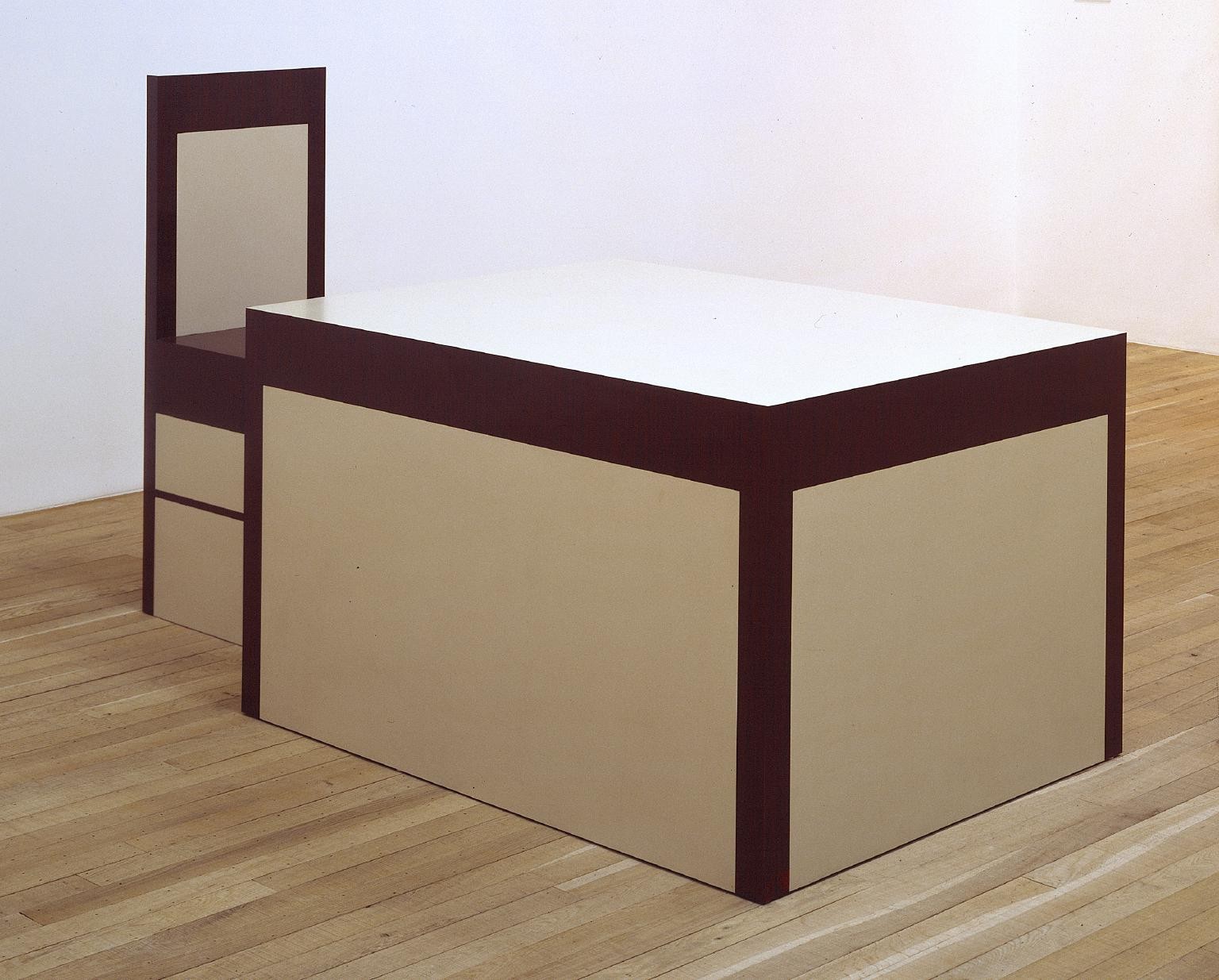
Εικ. 8: Richard Artschwager, Table and Chair 1963–4 Tate T03793 Photo © Tate
Κατάλογοι και άρθρα:
- https://www.thedaliuniverse.com/en/collection/surrealist-furniture#ref-294--Bracelli%20Lamp
- https://s3-us-west-2.amazonaws.com/sfmomamedia/media/uploads/files/DJ_InGalleryGuide_FA2_lg.pdf
- https://www.sfmoma.org/exhibition/donald-judd-specific-furniture/
- https://www.architecturaldigest.com/story/the-story-behind-franz-wests-iconic-chairs




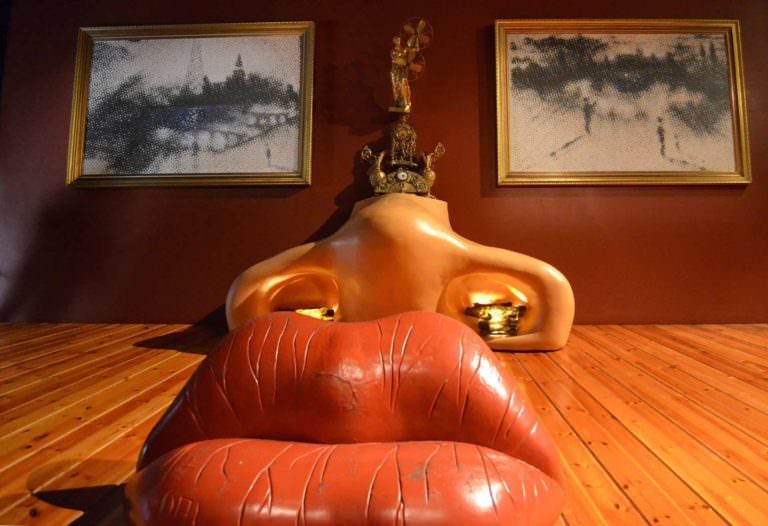
.jpg)
